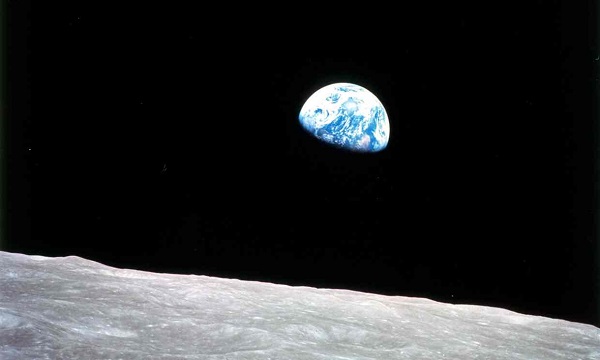
That image is a shot of the earth rising over the moon, photographed on Christmas Eve 1968 from Apollo 8, taken from a 2016 article by Martin Rees, looking at the dawn of the Anthropocene.
He plots two futures, one where we continue to degrade the planet, another more optimistic, where human societies could navigate current threats, achieve a sustainable future, and inaugurate a future more marvellous than what was achieved in the Holocene. He is interested in humans becoming electronic beings, which I’d see as a dystopia. Nevertheless, if humans act together, in the interest of the the broad ecology, including our species as a whole, our future could be bright.
In the real world we take action within nation states, which typically put the nation’s interest, however derived, ahead of other nations or indeed ahead humanity as a whole.
Internationally through the IPCC (Intergovernmental Panel on Climate Change) and the UNFCCC (United Nations Framework Convention on Climate Change) we are offered scenarios on climate change where, at best, the already bad will get worse. In the case of the latest IPCC 1.5°C report we are offered a 50% chance of avoiding the worst of a dangerous climate. Meanwhile, even if ‘successful’ sea levels will continue to rise, the Great Barrier Reef will be devastated, bad weather, droughts, floods and wildfires will get worse.
Unfortunately in Australia we have a government in power that intends to meet it’s commitments through cheap accounting tricks, where its environment department sees emissions continuing to rise through to 2030. Given that we are one of the largest per capita emitters in the OECD, our Paris commitments are exceptionally modest at 26-28% from 2005 levels. Those were initial commitments. A point overlooked is that under the Paris Agreement parties we undertook to ratchet up our commitments post 2020.
So what should Labor do if elected in 2022 to work towards a safe climate and a world were responsible growth and development is possible? What is a climate emergency, and can we respond appropriately?
I’ll start with Extinction Rebellion, who are going to extreme measures to tell us something.
However, this post was about 6500 words long, so for those who want a quick look I’ve added a summary section, which can serve as an advance organiser for those who go the whole journey.
Summary and conclusions
- Whatever you think of Extinction Rebellion’s tactics, their science is solid, and their proposals for action worthy of consideration. They are looking for zero net emissions by 2025.
- Paul Gilding has recently written a paper Climate Emergency Defined. Back in 2009, with climate scientist Jorgen Randers, he had proposed a climate emergency C-War, which was meant to start in 2018, reduce emissions by 50% in the following five years, and reach zero in 10 years after that. They would then draw down of 6 GtCO2e/year for the rest of the century (through carbon capture in various forms) to achieve 350 ppm by 2100. They were aiming for a safe climate rather than avoiding the worst aspects of a dangerous one. However, with this strong emergency action sea level rise would still peak at 1.25 metres around 2300.
- Gilding, without the help of a scientist, is now less specific on targets, but says we need more than a “big effort”. It’s bigger than Apollo, or the New Deal, up to 5-10% of GDP. We need to reinvent the global economy and our model of social progress. It’s a binary choice, but will bring rewards, as those who lived through WW2 found. Gilding is very critical of the IPCC for their approach to risk, which sees them treating the future of life on the planet in terms of the flip of a coin.
- James Hansen’s testimony to the US Congress in 1988 established climate change as a public policy issue. ‘Two degrees’ predates that, back to William Nordhaus in 1975. In 1990 the Swedes undertook an analysis of what constituted ‘dangerous anthropogenic interference’. They found two degrees definitely dangerous, one degree probably safe. They also said “Temperature increases beyond 1°C may elicit rapid, unpredictable, and nonlinear responses that could lead to extensive ecosystem damage.” As the situation worsened over the years, scientists and politicians accepted more risk in the 1°C to 2°C zone.
- Emergency action would have to be at scale, up to 5-10% of GDP, still less that WW2, but ongoing. It can’t wait until 2030. We need net zero emissions by 2030 or sooner, plus a significant drawdown of past emissions in order to cool the global surface temperature and stabilise sea level rise.
- The year 2007 was quite pivotal. We had had the Stern Review, the Fourth IPCC Assement Report, and a number of important books. We knew that the Eemian with 300 ppm had produced multi-metre sea level rise (5-6m was the estimate then), and in the Pliocene 3 million years ago with CO2 of around 25 metres with about 400 ppm. IPCC scenarios were beginning to become absurd. There was a big melt of sea ice in the Arctic, making nonsense of IPCC forecasts. James Hansen in December 2007 said in effect, “Stop, we’ve gone too far, we need to pull CO2 out of the air to get to 350 ppm, and then possibly go further for a safe climate.” The IPCC carried on regardless, focussing on avoiding the worst of a dangerous climate. Two degrees was accepted as an acceptable limit in the UNFCCC in 2010, and in many quarters wrongly seen as a guardrail, safe one side and dangerous the other.
- David Spratt, a science writer who has worked in editing and publishing, saw what happened to the Arctic sea ice in September 2007 and penned a piece The Big Melt in that October, calling for CO2 concentrations to be reduced to 320 ppm, a month ahead of Hansen’s announcement. He has been sticking it to the IPCC ever since, for the science they can’t see or persistently downgrade in significance, and to the UNFCCC for their lack of meaningful action. In recent times, with Ian Dunlop, a former international oil, gas and coal industry executive and chairman of the Australian Coal Association, Spratt has attracted international support, notably from Hans Joachim Schellnhuber, then head of the Potsdam Institute and advisor to the German government.
- Hansen, Spratt and many others consider that around 2015, with CO2 concentrations through 400 ppm, we have left the Holocene, and entered the Anthropocene. Change is permanent, but we have still the choice to take emergency action which may secure an ecologically sustainable planet – a livable place with growth and development.
- Meanwhile, in 2015 Johan Rockström, Will Steffen and 27 others, including Schellnhuber, Hansen, T.M. Lenton (known for tipping points) and T. Hughes (known for coral reefs) formulated a scheme of planetary boundaries with nine sectors, one of which is climate change, one is ocean acidification, then biodiversity (extinctions etc), land use change, freshwater use, biochemical flows, and so on. In several areas we have breached the boundaries. For climate their threshold is 350 ppm.
- The notion of ecological sustainability within planetary boundaries, and a safe climate seems like a logical statement that places climate concerns in the right framework, but some, especially developing countries, have seen it as constraining. Concepts like the ‘Green New Deal’ may be more attractive in winning hearts and minds needed to support drastic emergency action in a democracy, but as conceptualised in the US has a socialist flavour which may work against acceptance on a bilateral basis. However, an Australian Green New Deal can be anything we want to make it, and can be based on principles of ecological sustainability within planetary boundaries, and a safe climate.
So where to now? I think we’ll be furthest down the track in 10 years time if in government from 2022 we:
- 1. Revamp the Climate Change Authority (CCA), establish a national EPA and Environment Commission.
- 2. Undertake the first triennial (or 5-yearly) Australian Climate Change Assessment, as promised last election by Labor, with wide expert and public input.
- 3. Then formulate a comprehensive Climate Transition Plan to cover all sectors, not just energy, which would address the future of fossil fuel mining, stranded assets, a just transition for workers, as well as industry policies to support the industrial, social and cultural opportunities that will emerge. It would also review the management of the electricity system, including the role of the Commonwealth and the states, and determine which functions would be better in public hands.
- 4. Review and enact legislation as appropriate.
Meanwhile, make no promises that will limit ambition, or the ability to take action in relation to developing circumstances or information.
There is also masses of work requiring immediate attention, like what to do about a rogue Commonwealth energy minister, drought policy, reviews of the National Electricity Market (NEM) being undertaken by the organs set up by the COAG Energy Council, consideration of policy on Scope 3 emissions in fossil fuel mining developments, and so on.
Extinction Rebellion
Declaring a ‘climate emergency’ has become de rigueur, but in the case of Extinction Rebellion, discourse on what that might mean has been derailed in favour of arguing about free speech and the right to protest. When I last checked this site, climate emergency declarations had been made in 1,143 jurisdictions and local governments covering 287 million citizens within 22 countries. However, all that meant was a promise to formulate a climate action plan within six months. Extinction Rebellion demands more than that.
Looking at Extinction Rebellion’s statement of what the science is telling us, I’d say they have it just about right, in fact understated in a few places.
Their three demands are worth serious consideration:
- 1. Tell the truth
- Government must tell the truth by declaring a climate and ecological emergency, working with other institutions to communicate the urgency for change.
- 2. Act Now
- Government must act now to halt biodiversity loss and reduce greenhouse gas emissions to net zero by 2025.
- 3. Beyond Politics
- Government must create and be led by the decisions of a Citizens’ Assembly on climate and ecological justice.
They have a Draft Climate and Ecological Emergency (Declaration, Emissions Target and Citizens’ Assembly) Bill which sets up the proposed structures and procedures within the UK context, again worthy of serious consideration.
The only concrete target is net zero emissions by 2025.
Emergency action is needed, they say, because human activity is causing irreparable harm to the life on this world:
- Many current life forms will be extinct by the end of this century. We may right now be causing the Sixth Mass Extinction in Earth’s history.
The air we breathe, the water we drink, the earth we plant in, the food we eat, and the beauty and diversity of nature that nourishes our psychological well-being – our very health – all are being corrupted and compromised by the human values behind our political and economic systems and consumer-focussed lifestyles.
Also:
The effects of climate and ecological disruption that we are experiencing now are nothing compared to what could come. Catastrophic effects on human society and the natural world may spiral out of control if this climate and ecological emergency is not addressed in time.
-
Biodiversity Loss
Sea level rise
Desertification
Wildfires
Water shortage
Crop failure
Extreme weather
The combined result of these destabilising events will be:
- Millions displaced
Disease
Increased risk of wars and conflicts
Impacts on human rights
They provide this graphic of species in danger of extinction:
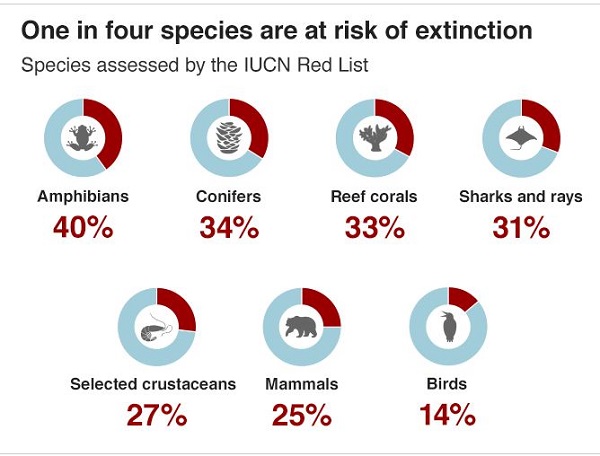
Insects, they say, are in trouble, from a wide range of pressures including habitat loss, agro-chemical pollutants, invasive species and climate change. As an example, a 27-year long population monitoring study in a set of nature reserves across Germany revealed a dramatic 76% decline in flying insect biomass.
On tipping points they link to a paper Will Steffen et al Trajectories of the Earth System in the Anthropocene, whence they get this image:
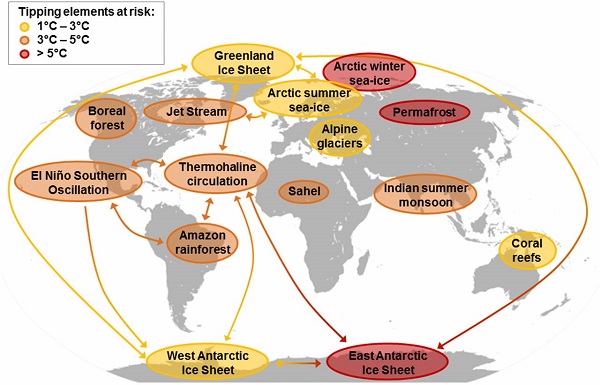
The case is compelling. However, they were not the first to suggest such dramatic action.
Paul Gilding and Jorgen Randers on climate emergency
Recently we have Paul Gilding’s paper Climate Emergency Defined.
Gilding, who is is a Fellow at the University of Cambridge Institute for Sustainability Leadership, has form. In 2009, with lead author Prof Jorgen Randers, he produced a truly astonishing paper The one degree war plan. An emergency is when the society decides to do “whatever it takes” before it is too late.
This is what they proposed:
- The paper finds that it is surprisingly simple to develop a plan which will reduce global emissions by 50 per cent in five years. It also seems possible to lower global emissions to zero in the ensuing decade, and then run negative emissions of 6 GtCO2e/year for the rest of the century (through carbon capture in various forms). The result, using the C-ROADS climate model, is to keep the temperature rise in 2100 below 1°C above the pre-industrial level. Much work needs to assure these conclusions.
They saw the C-War starting around 2018. Unaware of this, but aware of Beyond Zero Emissions’ claims that it is possible to reach zero in 10 years, I’ve been advocating at least since 2013 that we reach zero by 2030, then go negative to 350 ppm ASAP, and hope for the best.
Randers and Gilding were aware of James Hansen’s call for 350 ppm in December 2007, and it just happened that their plan would also reach 350 ppm around 2100. They saw the effects as follows:
- The CO2e concentration falls below 350 ppm by the end of the century, after peaking at around 440 ppm (Figure 2). Global temperature does temporarily rise above 1°C, in mid-century, but then falls below 1°C around the end of this century (Figure 3). The average sea level rises by 0.5 metres around 2100, and continues rising to a peak of 1.25 metres around 2300. While still very disruptive, we believe this is manageable with good preparation given the longer time frames.
They say that it is now (ie. in 2009) too late to prevent major disruption and damage in the decades ahead, as a result of inaction over the past several decades. Sea level rise above a metre is basically unavoidable. A big point is that they were aiming for a safe climate, not just avoiding the worst aspects of a dangerous one.
Their plan was devised using only one climate model, so they welcomed more work to be done by others. Obviously they had an eye on the Copenhagen meeting of the UNFCCC in December 2009, which was meant to do what Paris 2015 eventually did – decide post-Kyoto commitments.
They say emergency action presupposes a general “awakening”, which they thought would happen by 2020.
Of course, mitigation on that scale is always easier on paper than in the real world.
Gilding has written and spoken in terms of climate action as “The Great Disruption” ever since. In 2016 in CO2 War – What is it Good For? he says:
- There is no time left for multi-decade transition scenarios. At this late hour targets based around 2050, or calls for only zero emissions (without drawdown and cooling), are clearly not sufficient. They risk an unthinkable defeat by putting off the very concrete steps we need today.
What is needed is not just “a big effort”.
-
It is not a major project or a key policy initiative like the Apollo Program or even the New Deal. It is a comprehensive, economy-wide approach that, if done correctly, represents the only realistic way we can overcome the climate emergency.
We need to reinvent the global economy and our model of social progress. It’s a binary choice, but as with those who lived through WW2, but did not actually go to battle:
The sense of unifying purpose — the community working together to face down and overcome a frightening external threat, the shift in culture from self-focus and consumerism to collective focus and purpose — left them feeling their lives were better, happier and more worthwhile.
Gilding in his latest paper, without the help of a scientist and models, says we need to:
- Reduce CO2 emissions by significantly more than 45% in around 10 years;
- and Achieve net zero greenhouse gas (GHG) emissions well before 2050;
- and Remove warming gases from the atmosphere urgently to curtail system feedbacks;
- and Prove and scale geo-engineering solutions within a decade or two, possibly less, to cool the planet to a safe level.
He then says:
- Precision on whether the level of emissions reduction needs to be 45% or 100% by 2030, or whether the ultimate goal is to cap warming at 1.5°C or much less, does not need to be resolved at this stage. That’s because any target in this range requires such dramatic deviation from ‘business-as-usual’, and intervention that is so much stronger than any government is planning for, that it doesn’t change the answer to our question of whether a climate emergency mobilisation is justified.
We need to roll up our sleeves and mobilise. Targets will be set in the process.
To scope the scale of what he’s proposing he cites a study in the vicinity of 1-3.5% of GDP, or for a full-scale emergency mobilisation, which would be much more disruptive, around 5-10% of GDP.
His general assessment of the position we are in is summed up by this quote from Winston Churchill from 12 November 1936:
“Owing to past neglect, in the face of the plainest warnings, we have entered upon a period of danger. The era of procrastination, of half measures, of soothing and baffling expedients of delays, is coming to its close. In its place we are entering a period of consequences… We cannot avoid this period, we are in it now…”
(I’d suggest that in recent times Attenborough’s documentary has shown magnificently that global warming has now given us a climate which is already dangerous.)
On the recent IPCC 1.5°C report Gilding says:
- the IPCC report on 1.5°C was widely reported as concluding we needed to reduce CO2 emissions by 45% by 2030 (compared to 2010) and then to zero CO2 emissions by 2050 to keep warming below 1.5°C.
However, what the report actually says, in the detail, is that this is what is required if our goal is to have around a 50% likelihood of success.
A footnote tells that the IPCC say reaching zero by 2040 will improve our chances to 66%. This is appalling, irresponsible and unforgivable (my words, but he chides them roundly). Part of the problem, Gilding says, is in the science and part in the interpretation.
For explanation he goes to the thorough report by David Spratt and Ian Dunlop, What lies beneath, pointing out that Hans Joachim Schellnhuber, then:
- a professor of theoretical physics specialising in complex systems and nonlinearity, founding director of the Potsdam Institute for Climate Impact Research (1992-2018) and former chair of the German Advisory Council on Global Change. He is a senior climate advisor to the European Union, the German Chancellor and Pope Francis
wrote the foreword endorsing their critique. Inter alia, Schellnhuber says that it is hardly surprising that a trend towards “erring on the side of least drama” has emerged in the IPCC’s attempts to assess the multiple cause-and-effect relationships which comprise the climate problem. He says we are in a unique situation, there is no perfect analogue. The IPCC are doing the best they can. Finally:
- But climate change is now reaching the end-game, where very soon humanity must choose between taking unprecedented action, or accepting that it has been left too late and bear the consequences.
Therefore, it is all the more important to listen to non-mainstream voices who do understand the issues and are less hesitant to cry wolf.
Unfortunately for us, the wolf may already be in the house.
James Hansen’s testimony and the origin of two degrees
I think there was a problem at the outset. James Hansen’s testimony to the US Congress in 1988 established climate change as a public policy issue. In parallel The Intergovernmental Panel on Climate Change (IPCC) was established in 1988 by the World Meteorological Organization (WMO) and the United Nations Environment Programme (UNEP). Later it was endorsed by the UN General Assembly as an intergovernmental body of the UN:
dedicated to providing the world with an objective, scientific view of climate change, its natural, political and economic impacts and risks, and possible response options.
In 1992 the Rio Earth Summit established the United Nations Framework Convention on Climate Change (UNFCCC) with Article 2 of the convention committing countries to stabilise “greenhouse gas concentrations in the atmosphere at a level that would prevent dangerous anthropogenic interference [DAI] with the climate system”.
However, it stopped short of defining the level at which climate change became “dangerous”, despite growing calls for two degrees of warming to be set as a limit.
The idea of Two degrees came from Yale economist William Nordhaus in 1975. In 1990, when a team of researchers from the Stockholm Environment Institute (SEI) attempted to define what constituted dangerous climate change. They settled on two targets which they associated with bandwidth levels of CO2:
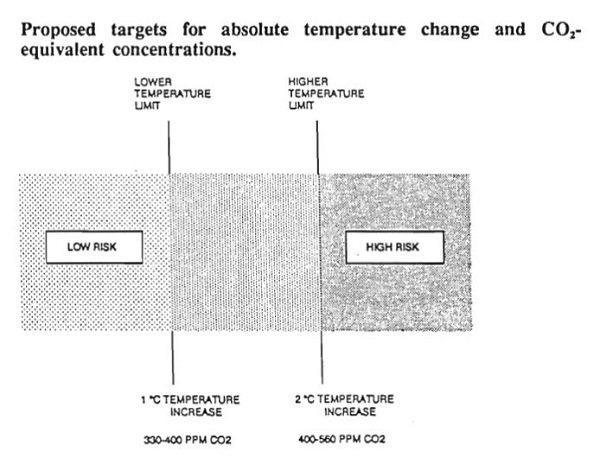
You would think that anyone looking for a safe climate would try to stabilise the earth system at less than one degree, especially after they said this:
- These two absolute temperature targets have different implications. It is recognized that temperature changes greater than the lower limit may be unavoidable due to greenhouse gases already emitted. The lower target is set on the basis of our understanding of the vulnerability of ecosystems to historical temperature changes. Temperature increases beyond 1°C may elicit rapid, unpredictable, and nonlinear responses that could lead to extensive ecosystem damage. (Emphasis added)
In other words, beyond 1°C, they said, we are in the zone of tipping points, although that metaphor for abrupt and possibly irreversible changes in the climate system was not applied to climate discourse until about 2005.
The CO2 bandwidths were wrong, because we now know that temperature effects of additional CO2 play out over a very long period of time, through longer-term feedbacks, beyond centuries. There is still uncertainty about where temperature will stabilise from given levels of CO2. At that time people spoke mainly about a 40-year lag.
Subsequently in 1996 the European Council of environment ministers declared that “global average temperatures should not exceed 2 degrees above pre-industrial level”. Then at the Conference of Parties (COP) of the UNFCCC in Cancún in 2010 governments committed to “hold the increase in global average temperature below 2°C above pre-industrial levels.”
However, when 2 degrees was accepted politically as a target or even (unwisely) as a ‘guardrail’, politicians accepted consequential risk.
The IPCC then responded by giving them scenarios that incorporated risk, usually 67%, which was normalised in a fashion which to me has always seemed outrageous. I protested in posts like A choice of catastrophes: the IPCC budget approach, but then who takes any notice of me?
However, the acceptance of unacceptable risk is still there whenever we think of 1.5°C as a desirable limit, which came into the frame largely through Anote Tong, then president of Kiribati, who learned at the Copenhagen climate conference (2009) that 2 degrees would see his country inundated. (Yes, it would, but so would 1.5°C.) He was successful in gaining 1.5°C as a desirable target at the 2015 Paris conference.
Personally, I’ve always favoured 280 ppm when it became known that the Eemian gave us multi-metre sea level rise with 300 ppm. I’m not sure when that association was first made, but certainly before 2006.
Climate emergency means action at scale
The Stern Review on the Economics of Climate Change published a comprehensive picture of climate change. Stern thought it would take 1% of GDP to mitigate climate change. In April the following year, after feedback, he said he had underestimated the effects of warming, and the cost would be 2%. Randers and Gilding’s proposal in 2009, according to Gilding’s 2019 paper (p.22) would have been in the vicinity of 1-3.5% of GDP.
Now Gilding says:
- It is reasonable to assume a full-scale emergency mobilisation, which would be much more disruptive, would require in the range of 5-10% of GDP dedicated to the task. This compares to WWII, for example, where the war effort required 30–50% of GDP, though for fewer years than a climate emergency mobilisation would likely last..
The 5-10% of GDP was not off the top of his head. He cites:
- The Global Commission on the Economy and Climate (2018) Unlocking the inclusive growth story of the 21st Century: Accelerating climate action in urgent times,
- and Global Commission on the Geopolitics of Energy Transformation (2019) A New World: The geopolitics of the energy transformation.
The climate emergency will not be resolved through BAU budgeting. So declarations of climate emergency are only words, to be judged by the action that follows.
2007 was a pivotal year
Back to 2007. There had also been the fourth IPCC Assessment report, Tim Flannery wrote The Weather Makers in 2005, in 2006 we had George Monbiot’s Heat, and Mark Lynas’s Six Degrees. George W Bush at the Heiligendamm G8 meeting came threatening to set up his own climate change sandpit. Apart from climate scepticism, the US had never ratified the Kyoto Protocol, in large part because it would have involved funding support for developing countries, including China. Angela Merkel persuaded him to do his thing co-operatively within the ambit of the UNFCCC.
That was June 2007, in September we had a Bush-initiated Major economies meeting on climate change and energy security where Yvo de Boer, Executive Secretary of UNFCCC gave an address on behalf of the Secretary General of the UN, which included the following:
- According to the scenario for the lowest stabilization level assessed by the IPCC, a long term goal in line with the latest science would include a peak in emissions in the next 10 – 15 years and a decline of emissions by 50% over 2000 levels by 2050. This would stabilise emissions at around 450 parts per million CO2eq in the atmosphere and correspond to a 2 – 2.4°C rise in temperatures.
There were a couple of very basic problems with that.
Firstly, CO2eq means including the full ‘Kyoto Six’ (CO2 plus methane, nitrous oxide etc). That means adding roughly 25% to CO2 levels to get equivalence. As he spoke CO2 levels were 387, so CO2eq was already at around 483 ppm. A kid with a calculator and some basic climate knowledge could have corrected him.
Secondly, science understood not only that 300 ppm as achieved in the Eemian 125kya was accompanied by 5-6 metres SLR (later revised to 6-9 metres), but also that the 350-450 ppm range was accompanied by sea level rise of 20-25 metres 3 million plus years ago There is an error margin, so the band is 5-40 or so; responsible planners should recognise the upper bound, not the midpoint.
That was from paleoscience. Back then, as now, the IPCC noted paleoscience but discounted it when settling on hard numbers.
That conference was on 27-28 September 2007. Earlier that week this is what happened to the Arctic sea ice cover:
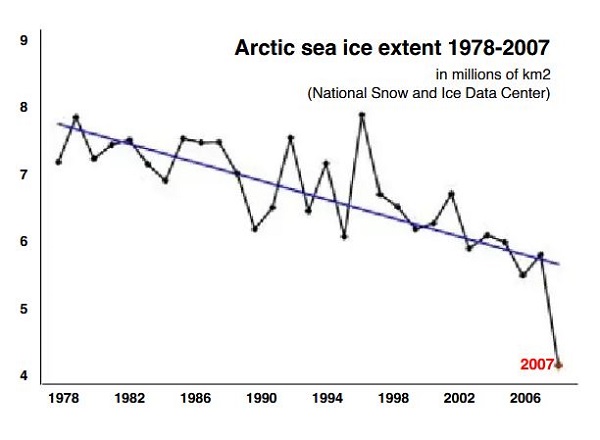
This is how that stacked up in relation to IPCC forecasts:
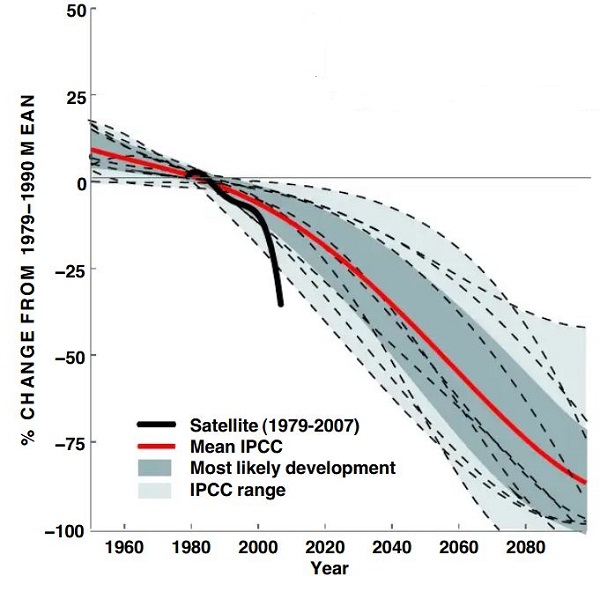
It dropped out of the bottom again in 2012 with a big cyclone in August breaking up the ice, and has been below 2007 levels ever since. In 2019 it was equal second lowest, not far behind 2012, without any special weather.
In that November of 2007 James Hansen gave important testimony to the State of Iowa Utilities Board. It is simply brilliant, and almost a necessary read if you want to understand climate change in its full geological context over the Cenozoic Era, the last 65 million years. He says in fact that you can’t understand what is happening now without taking paleoclimate science on board.
To my knowledge he was the first to have a halfway decent crack at identifying ‘dangerous anthropogenic interference’ (DAI), which, he said, comes in three aspects:
- Principal metrics defining dangerous include: (1) ice sheet disintegration and sea level rise, (2) extermination of species, and (3) regional climate disruptions (Figure 18). Ice sheet disintegration and species extinction proceed slowly at first but have the potential for disastrous non-linear collapse later in the century. The consequences of ice sheet disintegration and species extinction could not be reversed on any time scale of interest to humanity. If humans cause multi-meter sea level rise and exterminate a large fraction of species on Earth, they will, in effect, have destroyed creation, the planet on which civilization developed over the past several thousand years.
Regional climate disruptions also deserve attention. Global warming intensifies the extremes of the hydrologic cycle. On the one hand, it increases the intensity of heavy rain and floods, as well as the maximum intensity of storms driven by latent heat, including thunderstorms, tornados and tropical storms. At the other extreme, at times and places where it is dry, global warming will lead to increased drought intensity, higher temperatures, and more and stronger forest fires. Subtropical regions such as the American West, the Mediterranean region, Australia and parts of Africa are expected to be particularly hard hit by global warming. Because of earlier spring snowmelt and retreat of glaciers, fresh water supplies will fail in many locations, as summers will be longer and hotter.
We’d been told.
He argued that we were near the dangerous levels for all three of these metrics. SLR, for example, was then proceeding at twice the pace that had been observed earlier. He expected it to quicken further to become quite disruptive. In the longer term:
- Most of the world’s large cities are on coast lines (Figure 23). The last time that global mean temperature was 2-3°C warmer than now was in the Pliocene, when sea level was about 25 meters higher than today. About one billion people live within 25-meter elevation of sea level. As shown by Figure 24, most East Coast cities in the United States would be under water with a sea level rise that large, almost the entire nation of Bangladesh, the State of Florida, and an area in China that presently contains about 300 million people.
Building ice sheets, he says, was a slow, dry process. Antarctica has extreme desert-style precipitation rates. Deglaciation is by contrast, wet, fast and erratic. At the time Hansen was pointing out that if deglaciation doubled every 10 years we would have 5 metres of SLR by 2100. Now he emphasises that it is too soon to say what will happen in the next century.
Hansen warned that if we reached 400ppm by 2015, as we would under BAU, then dangerous climate change would be unavoidable.
He advocated no new coal-fired power without sequestration in advanced countries from 2012, ditto for developing countries by 2022, bulldoze the lot by 2050. He saw sequestration as 10 years away as an available technology, but then we should use it to draw down CO2 from the atmosphere, ie. from 2017.
He thought that if we tried hard we could perhaps limit warming to 1°C from “now”, meaning 1.8°C from preindustrial. At the time he said he retained some optimism, but:
- The climate surely is approaching tipping points, with the potential for us to lose control of the consequences.
He said that in 2007.
He says the young want to see deeds rather than words.
A month later he told 25,000 scientists at the American Geophysical Union annual conference, that we should aim for 350 ppm for a safe climate. That is CO2, assuming that the other Kyoto gases have been neutralised, which by my count means 280 ppm CO2 if you limit the others to what they were naturally. In any case, he said it should be an interim target. When we get there we’ll have a better idea as to what should happen next.
In 2009 IPCC chairman Rajendra Pachauri’s call for 350 ppm was hailed by Bill McKibben as a breakthrough moment for the climate movement, but the call somehow got lost in the mist.
In 2011 Hansen said 450 ppm constituted a “long-term disaster” if we wanted to keep the ice sheets and stable shorelines etc.
He said we needed 350 ppm, and “possibly somewhat less.”
Gwynne Dyer’s June 2008 piece is priceless. See Last exit for the Holocene [on the highway to Perdition.] Dyer, with a defense background was a columnist published in 170 papers. Early in
2008 he had talked to top defence officials around the world, and top climate scientists. The result was the book Climate Wars, a dystopian scenario, where he saw civilisation falling apart over the next half century. Entertaining, but actually a serious piece of work based on the best expert opinion.
David Spratt
Back to 2007, and enter David Spratt. He is essentially a science writer who has worked in editing and publishing, who saw what happened in September 2007, and penned The Big Melt, which later, with Philip Sutton, was expanded to the book Climate Code Red.
- We must choose targets and take actions that can actually solve the problem in a timely manner.
The object of policy-relevant advice must be to avoid unacceptable outcomes and seemingly extreme or alarming possibilities, not to determine just the apparently most likely outcome.
The 2°C warming cap is a political compromise; with the speed of change now in the climate system and the positive feedbacks that 2°C will trigger, it looms for perhaps billions of people and millions of species as a death sentence.
To allow the reestablishment and long-term security of the Arctic summer sea ice it is likely to be necessary to bring global warming back to a level at or below 0.5°C (a long-term precautionary warming cap) and for the level of atmospheric greenhouse gases at equilibrium to be brought down to or below a long-term precautionary cap of 320 ppm CO2e.
The IPCC suffers from a scientific reticence and in many key areas the IPCC process has been so deficient as to be an unreliable and dangerously misleading basis for policy-making.
(Emphasis added)One of the key issues is climate sensitivity, the amount of warming derived from doubling CO2. The standard short-term (Charney) effects give warming with a midpoint of around 3°C, which is what is included in the computer models, and recognised by the IPCC. Hansen found that if the long-term effects played out in the scale of millennia through effects such as ice sheet decay and vegetation change, then the value became more like 6°C. (See my 2016 post Reconciling estimates of climate sensivity).
However, for the IPCC the problem is that there is no good way of tweaking the models to forecast what will happen in the next century or two based scientific measurements of the recent past. So the IPCC note the possibility, and basically ignore what they can’t see in the hard data in order to come up with a hard figure. This is then accepted as gospel politically.
Hansen tries to interpret the story, and that shows that (400-600) ppm may well give a temperature variance of 5 to 7°C and SLR of 75m (complete deglaciation).
CarbonBrief’s explainer shows how IPCC has rated against the actual studies of SLR:
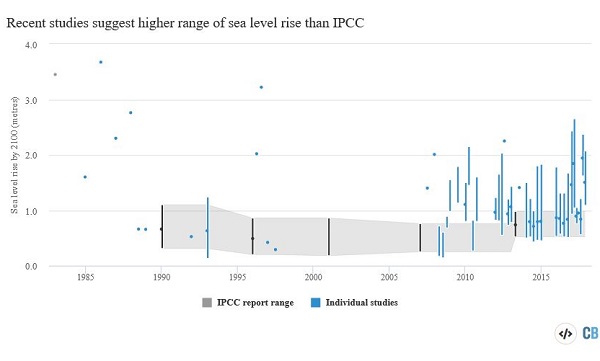
The dots represent the midpoints and the bars the uncertainty range. Policy makers and politicians should pay attention to the upper bounds to keep us safe.
CarbonBrief’s summary of the IPCC report, in the ice sheets section, says:
Taken together, the report says the combined sea-level rise contribution from both ice sheets was around 1.2mm each year between 2012 and 2016, a 700% increase from two decades previously.
Clearly the ice sheets have tipped. Yet the hard number in the IPCC report is a maximum of 1.1 metres, up from 98cm in the fifth Assessment report of about five years ago. Compare that with a recent study led by Kiwi Dr Georgia Grant:
- New Zealand researchers have found that Antarctic ice sheets are capable of widespread melting, raising the sea level by up to 20 metres under current atmospheric carbon dioxide conditions. (Emphasis added)
Richard Alley, respected glaciologist, says 15 To 20 Foot Sea Level Rise [is] Possible Sooner Rather Than Later.
What we do know is that the climate is being forced 1000 times harder than it was in the mid-Miocene, when it was about continental drift, weathering rock from new mountains and such, and at least 10 times harder than coming out of the last ice age. We do know that 93% of the extra heat generated by global warming goes into the ocean, only about 2.3% directly into the atmosphere. We do know that a third of the Antarctic ice sheet is below sea level now. There in no analogue for how SLR proceeds in these circumstances. We are in a situation never seen before in the history of the planet.
Trying to look at the data of ice sheet melting from the last two decades and from that predicting the end state is like trying to forecast the year from the data of the first five minutes.
David Spratt by establishing the blog Climate Code Red continued to talk truth to power.
Back in September 2013 Spratt addressed the issue Is the Climate Already Dangerous?, answering in the affirmative. The report is pay-walled, but he says the answer is:
- both shocking, and necessary, if climate policy-making is to escape the delusional paradigm within which it is stuck.
In a concluding section, this report argues that with clear evidence that climate change is already dangerous, we are in an emergency and face “…an unavoidably radical future”.
Then in 2014, as I reported in The game is up Spratt let us know there was no budget of burnable carbon, just so that we knew in the run-up to the Paris conference. In fact in the book Climate Code Red:
- The tipping points for large ice sheet and species loss were crossed when we exceeded 300-350 ppm of carbon dioxide in the atmosphere…
Ironically, the 350 ppm point was reached and breached in August 1988, that’s two months after James Hansen’s testimony to Congress. There never was a budget of burnable carbon for policy-makers to consider.
In September 2016 he gave us Unravelling the myth of a “carbon budget” for 1.5C. There is none; 1.5°C is unsafe and we best get back to 325 ppm.
In April 2018, ahead of the IPCC report, he gave us at RenewEconomy Climate change: 1.5°C is closer than we imagine. The 1.5°C IPCC thing was basically “a political fix in which grand words masked inadequate deeds.” What worries him most?
- It is my experience that with few exceptions neither climate policy-makers nor climate action advocates have a reasonable understanding of the imminence of 1.5°C and its consequences.
In that post Spratt links to a paper by James Hansen with 14 joint authors Young people’s burden: requirement of negative CO2 emissions (2017). This is a graph from that paper, with some value adding by Spratt:
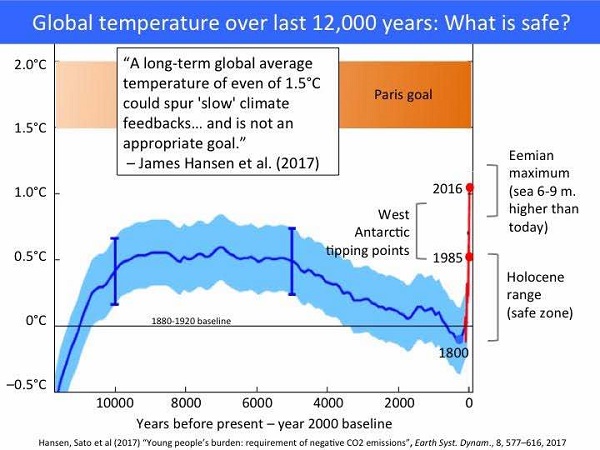
In recent times Spratt has been joined by Ian Dunlop, a former international oil, gas and coal industry executive, chairman of the Australian Coal Association and chief executive of the Australian Institute of Company Directors, also a member of the Club of Rome, and together they have launched Breakthrough (National Centre for Climate Restoration) which has attracted international attention.
Planetary boundaries
Through Climate code red I found my way to this wondrous graphic, which addresses and I think resolves how climate change can be properly conceptualised within general environmental concerns:
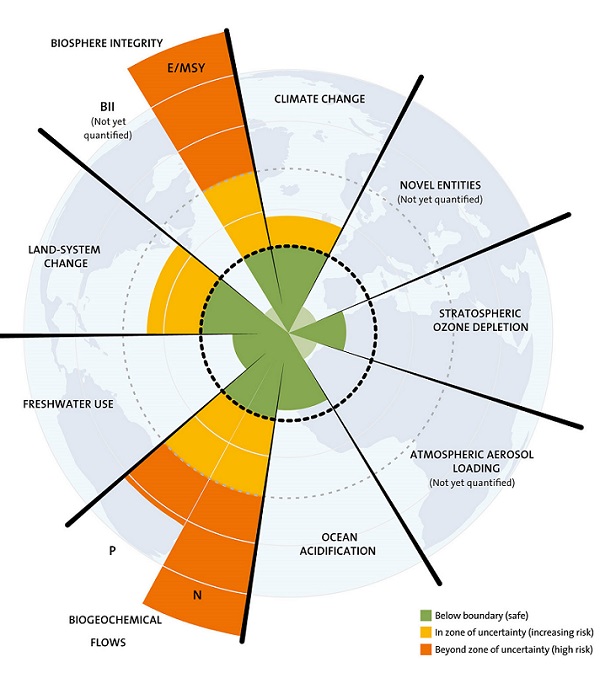
You’ll see various versions around the traps. That one comes from the Stockholm Resilience Centre at Stockholm University. The basic concepts are ecological sustainability and planetary boundaries. The segments are related and blend into each other. The green inner space is safe within the planetary boundaries. The yellow zone represents risk and uncertainty. The outer zone means we’ve tipped to dangerous levels.
Climate in their representation is still in the yellow zone, suggesting that all may not be lost.
Unsurprisingly, when you see the list of authors where the concept originated, the safe threshold for climate is 350 ppm.
The concept was hatched mainly by Johan Rockström and Will Steffen. The original paper is Johan Rockström et al Planetary Boundaries: Exploring the Safe Operating Space for Humanity 35pp 2015. The paper has 29 authors, including H. Schellnhuber, J. Hansen, T.M. Lenton, known for tipping points, and T. Hughes, known for coral reefs. (The concept was aired earlier in 2009.)
A meeting of great minds. Rockström has now succeeded Schellnhuber as head of the Potsdam Institute for Climate Impact Research.
A more readable version is Johan Rockström, Will Steffen, et al A safe operating space for humanity Sept 2015, which says about climate change:
- We propose that human changes to atmospheric CO2 concentrations should not exceed 350 parts per million by volume, and that radiative forcing should not exceed 1 watt per square metre above pre-industrial levels. Transgressing these boundaries will increase the risk of irreversible climate change, such as the loss of major ice sheets, accelerated sea-level rise and abrupt shifts in forest and agricultural systems. Current CO2 concentration stands at 387 p.p.m.v. and the change in radiative forcing is 1.5 W m−2 (ref. 11).
If you want to follow up the ‘1.5 W m−2’ concept, read Hansen’s magnificent exposition of climate science (2004, I think) in Can we defuse the global warming time bomb? Normal radiation is 238 watts per square metre. Human activity had increased that by 1.5 watts per square metre at that stage. The suggestion is to turn that back to one, being the equivalent of a Christmas light bulb.
I think that is too obscure to be useful in communicating the science.
Hansen in the Iowa Testimony thought that species extinction could hopefully be limited to 10%. The Rockström paper says the rate of extinction of species is estimated to be 100 to 1,000 times more than what could be considered natural.
We are going to have to make choices and determine priorities. Not everything can be saved.
However, we also need a concept of growth and development. Energy in the new world may be plentiful and cheap. Economic growth will, with a bit of luck, mean that we can have richer human experiences without placing a damaging burden on the planet.
On the general conceptualisation of climate change and the environment, I think the key concept is this:
- Ecological sustainability within planetary boundaries and a safe climate.
You can play around with the word order, but there should be a note along the lines:
- Ecological sustainability will include preservation, restitution and enhancement along with responsible economic, social and personal growth and development.
Something like that. Human choice as the significant factor in ecological futures is the very essence of the Anthropocene. How dire things will become is uncertain, but some think very dire. Prof Jem Bendell has come up with the concept ‘deep adaptation’. See his paper which no journal would publish or his Deep Adaptation Forum./ There’s more at Item 11 in my post Climate action: a doddle or deep adaptation?
That may be true, we don’t know. However, fear inspires some to superhuman effort, but paralyses others, so it may not the best overall motivator. The planetary boundaries concept had an outing in the UN climate forum. I’ve lost the link, but the story ended badly. The meeting accepted the concept, but the session was erased from the report because of kick-backs from the developing countries. It seems they saw their development constrained, and perhaps funding drying up.
Unfortunately the Kyoto Protocol of 1997 allowed developing countries (China is one such) to pollute their way to prosperity by using fossil fuels with gay abandon on the basis of a budget of burnable carbon that did not exist. This is still the case. The UNFCCC and the IPCC were in effect operating on a Ponzi scheme in calculating on burnable carbon.
Meanwhile the notion of a Green New Deal offers growth and dynamism in its language:
- Enact an emergency Green New Deal to turn the tide on climate change, revive the economy and make wars for oil obsolete. Initiate a WWII-scale national mobilization to halt climate change, the greatest threat to humanity in our history. Create 20 million jobs by transitioning to 100% clean renewable energy by 2030, and investing in public transit, sustainable (regenerative) agriculture, conservation and restoration of critical infrastructure, including ecosystems.
- Implement a Just Transition that empowers those communities and workers most impacted by climate change and the transition to a green economy. Ensure that any worker displaced by the shift away from fossil fuels will receive full income and benefits as they transition to alternative work.
- Enact energy democracy based on public, community and worker ownership of our energy system. Treat energy as a human right.
- Redirect research funds from fossil fuels into renewable energy and conservation. Build a nationwide smart electricity grid that can pool and store power from a diversity of renewable sources, giving the nation clean, democratically-controlled, energy.
- End destructive energy extraction and associated infrastructure: fracking, tar sands, offshore drilling, oil trains, mountaintop removal, natural gas pipelines, and uranium mines. Halt any investment in fossil fuel infrastructure, including natural gas, and phase out all fossil fuel power plants. Phase out nuclear power and end nuclear subsidies. End all subsidies for fossil fuels and impose a greenhouse gas fee/tax to charge polluters for the damage they have created.”
That sounds wonderful, apart from the slight problem of a bolshie, anti-capitalist element from the third dot point on. Frankly, I don’t think you can win the hearts, minds and votes of the citizens from a position on the left of the left wing of the Labor Party, and well to the left of The Greens, as I understand them. At the same time I have not given up on the liberal democratic project of civilising capitalism. Certainly we could do with more co-operatives, and there is scope for more industrial democracy, such as in the German industrial relations system for large companies where:
- There’s a supervisory board, representing both shareholders and workers. A management board, comprising senior management, is accountable to the supervisory board. Then there’s a works council, which oversees the implementation of employment laws and rights and negotiates with management over issues such as hirings and firings.
Another important consideration is that climate and environmental action need to be bipartisan if they are to endure.
I have been told by someone who should know (having done a PhD and taught on the topic) that climate effects on health, which are significant, is effective in personalising the issue, which can seem remote and ‘expert’, especially through stories of cases.
So how we package plans while maintaining integrity is a matter for consideration. However, an Australian Green New Deal can be anything we want to make it, and can be based on principles of ecological sustainability within planetary boundaries, and a safe climate.
Where to now?
Labor has said in the past that it would follow the science and honour Australia’s Paris Agreement commitments.
So it should, but the fact is that when the planet last had 400 ppm just over 3 million years ago there was sea level rise of 20 to 25 metres (midpoint, with upper bound around 40 to 45m).
The planetary boundary of 350 ppm was actually crossed in August 1988, 2 months after Hansen’s US Congress testimony. Since then there has been no burnable carbon compatible with a safe climate. What the science and politics of the IPCC and UNFCCC has done since then is to offer us outrageously irresponsible odds, mostly a 67% chance, now only 50% for 1.5°C with the aim of avoiding the worst of a dangerous climate, as Gilding says, a flip of the coin for the future of the planet.
Currently the ‘best science’ Labor is following was a 2014 compromise with reality made by a committee of experts. This graph is from page 48 of the Climate Change Authority review of February 2014:
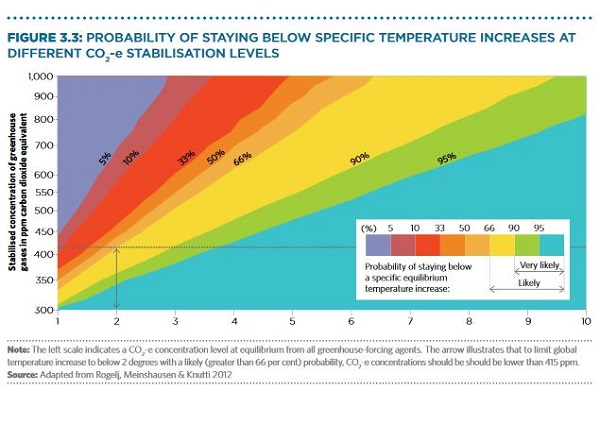
The accompanying text says:
- An atmospheric greenhouse gas concentration that provides an approximate 67 per cent probability of limiting warming below 2 degrees, shown by the horizontal dotted line, is also projected to give about a 90 per cent probability of staying below 3 degrees, and more than 95 per cent probability of staying below 4 degrees; however, it gives only a 10 per cent probability of staying below a 1 degree temperature increase.
When you realise that the Eemian 125,000 years ago gave us 6-9 metres of sea level rise with 300 ppm CO2, you should understand that there was no safe climate on that graph at all.
Would you believe, that graph is graduated in terms of CO2e? When those rational and alert CCA people were looking at it, CO2 levels were 395 ppm, making CO2e back then about 493. The report is 401 pages, so perhaps they missed it completely. That’s the kindest interpretation of what happened.
We have to do better than that, but cannot simply declare a climate emergency and proceed to spend more than we currently spend on defence. Any enduring effort needs a social licence and ultimate bipartisan support.
We may need to make some interim plans, but our best bet long term is to put in place processes and structures that will use the resources of government to maximum effect in a broad consultatiove process.
So when Labor in office revamps the Climate Change Authority (CCA) it should include at least two scientists who understand paleoclimate science.
Labor’s existing National Platform Chapter 4 para 14 (p 76) says:
-
Labor accepts the science of climate change.This reflects the broadly held view of the Australian community. Australia needs constructive, inclusive debate and evidence-based policy, so Labor policy is informed by scientists, economists, environmental and climate stakeholders, farmers, business, industry, unions, community organisations and governments. We have and will continue to consult thoroughly and comprehensively on policy based on the views of the experts and the community. Labor will adopt innovative approaches to limit climate change and our collective energy challenge.
Labor should then ask the CCA to oversee the first of what would become periodic (triennial or 5-yearly) Australian Climate Assessments. This requires the resources of government, rather than a political party. Moreover, everyone then has an opportunity to input, which is important to build support and bipartisanship.
After that we should develop a Climate Transition Plan to cover all sectors, not just energy, which would address the future of fossil fuel mining, stranded assets, a just transition for workers, as well as industry policies to support the industrial, social and cultural opportunities which will emerge. It would also review the management of the electricity system, including the role of the Commonwealth and the states, and which functions would be better in public hands.
At the last election Labor also promised to establish a national EPA and Environment Commission.
Obviously there will be a need to review and enact legislation as appropriate. On achieving power, initial legislation could be passed to lock in the framework for subsequent action, the procedures and structures to carry us forward.
Meanwhile, make no promises that will limit ambition, or the ability to take action responding to developing circumstances or information.
[Update: My younger brother has suggested that it is folly going to an election without concrete numeric targets, effectively promising to set up a committee. He’s right. We should adopt the latest numbers from the Climate Change Authority, or IPCC, whichever is latest, and put “at least” in front of them.]
Plus, there is also masses of work requiring immediate attention, like what to do about a rogue Commonwealth energy minister, drought policy, reviews of the National Electricity Market (NEM) being undertaken by the organs set up by the COAG Energy Council, consideration of policy on Scope 3 emissions in fossil fuel mining developments, and so on.
If you are still with me, thankyou for your persistence. I’ll finish with a link to David Spratt’s latest – “We would never board a plane if we only arrive in half the cases, but this is the method in international climate policymaking” – an interview with risk researcher Christian Mihatsch:
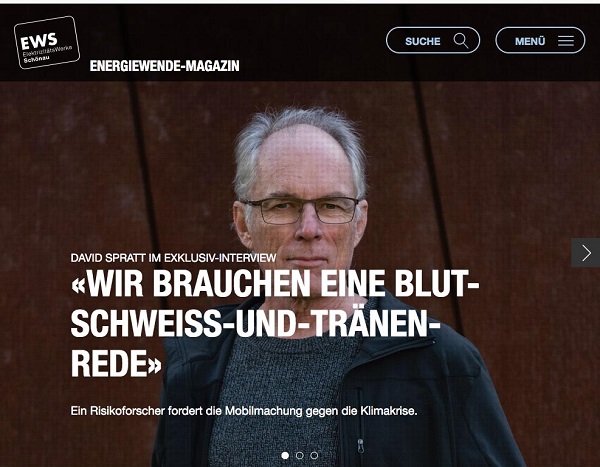
The man is telling us we need a ‘blood, sweat and tears’ speech.
Some inspirational leadership would not go amiss.
Update 17 December 2019:
When I wrote this post I completely forgot a post Assessing dangerous climate change I had written in December 2013 based on a paper by James Hansen and 17 other authors Assessing ‘‘Dangerous Climate Change’’: Required Reduction of Carbon Emissions to Protect Young People, Future Generations and Nature.
It’s Hansen’s answer to the climate emergency. It calls for a 6% reduction in emissions each year, starting immediately, that is, in 2013. They warn:
If emissions continue to grow until 2020, as seems likely, emissions will need to reduce by 20% pa thereafter.
In addition, we will need to remove 100 GtC from the atmosphere and hold other greenhouse gases to net zero.
That’s carbon, not CO2. For CO2 multiply by 3.67.
100 GtC is roughly 10 years of emissions.
They suggest an initial carbon tax of $15/tCO2 with a rise of $10 each year to change behaviour, and border taxes for embedded carbon imports.

Done, and I’m going for a walk.
The first thing I noticed on publication was a typo in the first paragraph, so I may be fiddling with this for a while.
From Wolfgang Knorr at Lund University – Our profession is letting down humanity – we must change the way we approach the climate crisis:
Just a note on science.
It’s true that science follows a careful path from hypothesis to experiment/observation, and rigorous review of results.
For several reasons:
* history is full of plausible-but-false hypotheses that were accepted in the past, which held up the advancement of knowledge by obscuring truth, and sending people off on unproductive and expensive side tracks
* the proponent of an hypothesis is not always well placed to subject it to logical or experimental scrutiny; there is some safety in broadening out the pool of critics beyond the scientist and her immediate colleagues
* mistakes need to be corrected on the public record ASAP
* “uncertainty limits” in both observations and predictions need to be published, so the reader can estimate what reliability to assign to another worker’s results
Hence scientific progress and ethics demand:
honesty
self-awareness
self-criticism
widespread publication
rigorous refereeing of published work
exploratory follow-ups to confirm or query announced results
sifting of wheat from chaff
etc.
These procedures and ethics work well in physics, genetics, chemistry, engineering, geology, mathematics, statistics…..
It’s trickier in “climate science”. That stems, I think, from the field’s complexity, the relative crudity of current models, the global/local divide, the sheer range of contributing basic sciences, the relative paucity of observational data (and continuing disputes over their relevance and interpretation).
Then there’s the overlay of politics, economics, finance, vested interests, ……
While I want public and private policy to be based on facts, which in this area means scientific facts, I think our insistence on clinging to the term Science causes confusion.
I propose the adoption of a new term, perhaps
Climate Change Risk Specialists???
It is risk we need to anticipate, plan for, and reduce.
***
There is a risk of catastrophic nuclear war.
That risk needs to be reduced to as low a level as possible.
The physicist understands how nuclear fission occurs; she can’t be expected to abolish nuclear arsenals. The GP knows about illness and disease caused by atomic fallout, or nearby detonations of H-bombs; she can’t directly cause disarmament, though she might work on “civil defence” awareness.
Yes, conscience stricken physicists from 1945 onwards worked publicly to warn of weapons dangers…. where did that get us all? We’re all in this together.
First they bombed the Japanese, but I wasn’t Japanese.
Then they targeted Europe, USSR, USA, but I lived on the other side of the globe.
Then China, India, Pakistan, Israel, South Africa, ….. but no worries cobber.
Now Iran, DPRK, …….
Please let scientists continue their work as scientists.
Rev. Ambi
My sermon was addressed to Wolfgang Knorr, not to you, Brian.
(BTW, I’ve heard of Godwin’s Law in political debate. Should there be a Rutherford’s Law, that the first person to mention nuclear war loses any argument about Global Warming??)
Lord Rutherford of Nelson is famous for saying that any talk of atomic energy was “moonshine”.
Brian the link to the report I mentioned that said linking climate change to health is persuasive is here
https://www.sustainability.vic.gov.au/About-us/Research/Health-and-Climate-Change-Research
It actually says people have low awareness of the link between climate change and health, but once they’re informed about it, it’s very persuasive, making climate change seem much more real and personally relevant.
The idea about case studies being persuasive was my speculation, on which I was looking for feedback. I will also get feedback from students this week (to a slightly different but related question) so that should be interesting.
Thankyou Ambi and Val.
My younger bro has also bent my ear. Need to pack now. Fly to Synney tomorrow!
They don’t call it Sinny for nothing, Brian.
Careful!!
The message at 6.58am to Brian was in the nature of private pastoral advice.
I will add one more suggestion (which I never thought I would advise any parishioner): stay away from The Cross.
Rev Ambi
pax vobiscum
Val
Could you please show the group any evidence at all that global warming has increased mortality?
Everywhere I look the climate related deaths have thankfully decreased dramatically in the last 50-100 years.
I’m not sure cherrypicking ever rarer instances will fool to many into thinking climate related deaths are increasing.
There’ll be a few gullible youth though, I guess that’s the target.
And where is that, pray tell?
For someone who demands E…Vid…Ence from everybody else you supply very little as a quid pro quo.
My own research (literally 10 seconds with Google) threw up this resource which appears to disagree with everywhere you have looked.
The three co-authors of a new book suggest reasons for scientists’ downplaying risks
but their piece appears in “The Guardian” online, where some might not look.
You have been warned, MJ.
Zoot, go to EM-DAT for reliable data rather than a trumped up NGO desperate for taxpayer loot.
Mr A, I’ve been warned about a lot of people.
Who hasn’t been warned by the Guardian about everything?
Jumpy, it would appear CRED (which runs EM-DAT) is just another trumped up NGO desperate for taxpayer loot.
From here, my emphasis added.
And you didn’t link to any E…Vid…Ence for your assertion that climate change has not increased mortality.
I meant, you have been warned not to follow the link, MJ (abbreviation of “Mr J”).
Think of it as a trigger warning, …….
Addendum to my previous comment.
In their Disater Mortality Report CRED notes
Jumpy, you deserve some kind of award for hyperbole. I have never before in my life heard the World Health Organization, that venerable body established in 1948, described as “a trumped up NGO desperate for taxpayer loot”. No doubt they’re all in despair at WHO HQ – ‘we’ve fooled everybody for over 70 years, but now Jumpy is on to us’.
Also colleagues of the late Professor Tony McMichael, first author of the report linked in zoot’s post, might be surprised by your attitude. Jumpy vs the (late) “world’s authority on the impact of climate and health” – who to trust?
Actually the report zoot linked is quite old now (Tony McMichael died in 2014 and was producing work right up till then, with his last book published posthumously but that report looks to be from 2001).
I could look for a more recent report, but I’m never sure if it’s worth responding to your requests for evidence, Jumpy, because I’m not you’re not going to take any notice of it.
What do you think? Am I someone who is making things up to fool “gullible youth” and make $ for the University? (The students I teach are actually graduate students so mainly mature age, btw, hopefully that protects them from being duped by pernicious types like me.) Or would you take notice of evidence if I produced it?
“world’s authority on the impact of climate change on human health” – sorry for carelessness in quote!
Val
You have neatly answered a very profound question:
WHO is WHO?
We may anticipate further encouragement from you, in discovering various obscure, tiny outfits such as BOM, UN, NASA, ADF, Red Cross, …. and BTW did they name some “university” after a WW1 General and engineer???
Yes Ambi, who is who and what is what? How can we ever know? What does it all mean? Is ‘Monash’ a ‘university’ or just a trumped up NGO trying to look good by naming itself after a famous war commander?
(Hmm, now that you ask … No I will not make fun of my employer! How could I think of doing such a thing?)
😉
Val, perhaps Bond University could be a better fitting rent seeker for your line of …erm… qualification.
Just a thought, no evidence.
Jumpy
You’re a builder, aren’t you?
How would you like it if I started implying that you’re passing yourself off as a builder in order to rip off gullible people?
I think you should drop this line of personal abuse and answer my question.
If I provided you with an up to date, comprehensive report on climate change and health, would you read it?
Val, he has told us he’s not a builder. He’s a subbie who works in an aspect of the building trade. He can explain more if he wishes.
Val, I’ll check out that health link when I can. My impression on the weekend is that Sydney is not suffering to the same extent as we are from extraordinary weather. Here selective trees are dying, and the jacaranda season was a pale a pale shadow of what had been it’s splendid exuberance of colour.
Further west in Sydney it no doubt different, but I wonder whether the people with real power in Sydney, Melbourne and Canberra can see climate change by looking out of their window.
Even here, some just enjoy the warmth of the winter when the days are about 5 degrees warmer than average.
It’s different in Pacific Islands, where even without storms sea level rise is penetrating where they grow and harvest food.
Val, you’ll never convince Jumpy, or if you do he doesn’t admit it.
However, the rest of us find what you dig up interesting.
It’s obviously your call as to how you spend your time.
I’ve posted an update:
When I wrote the post I completely forgot a post Assessing dangerous climate change I had written in December 2013 based on a paper by James Hansen and 17 other authors Assessing ‘‘Dangerous Climate Change’’: Required Reduction of Carbon Emissions to Protect Young People, Future Generations and Nature.
It’s Hansen’s answer to the climate emergency. It calls for a 6% reduction in emissions each year, starting immediately, that is, in 2013. They warn:
If emissions continue to grow until 2020, as seems likely, emissions will need to reduce by 20% pa thereafter.
In addition, we will need to remove 100 GtC from the atmosphere and hold other greenhouse gases to net zero.
That’s carbon, not CO2. For CO2 multiply by 3.67.
100 GtC is roughly 10 years of emissions.
They suggest an initial carbon tax of $15/tCO2 with a rise of $10 each year to change behaviour, and border taxes for embedded carbon imports.